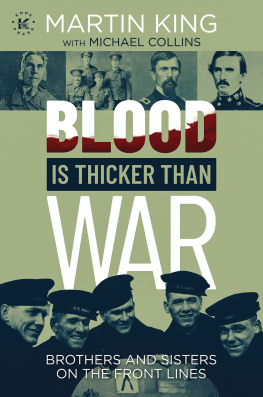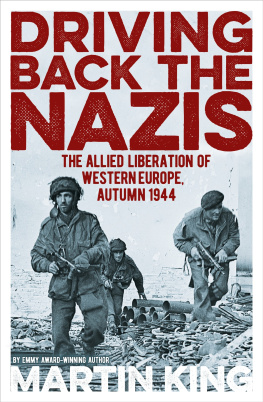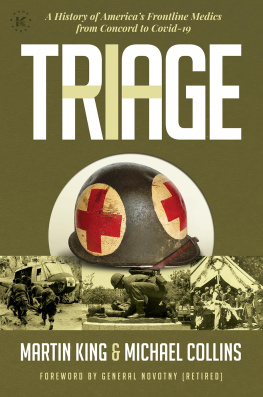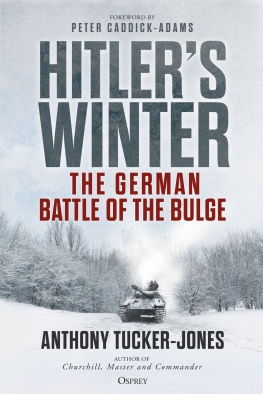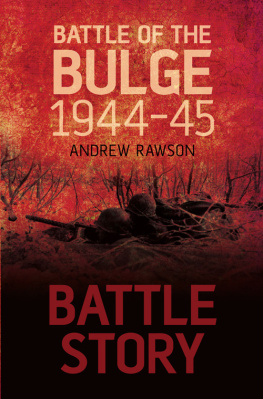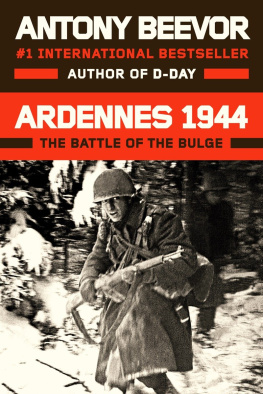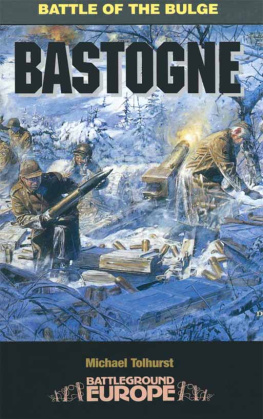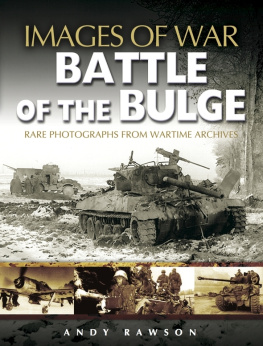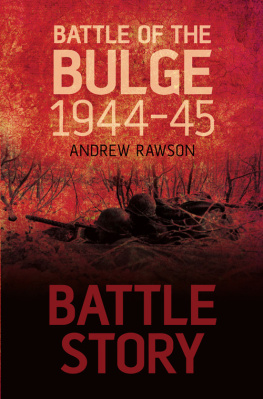For all Battle of the Bulge veterans past and present.
This book is dedicated to my wife Freya, kids Allycia and Ashley, all family members and Battle of the Bulge veteran, dearly respected friend John Schaffner, Scout, Battery B, 589th Field Artillery Battalion, 106th Infantry Division. Many thanks to John Turing and Arcturus Publishing for asking me to write this volume. Also thanks to former General Graham Hollands, former Naval Commander Jeff Barta and former 101st Airborne Commander Robert Campbell. Thanks also to Mike Collins for his support and assistance.
Foreword
With each generation, epic historical events seem to recede into the background and slowly fade from memory. But some moments in history are just too pivotal and important ever to be forgotten. This story, about the Battle of the Bulge, is one such event.
In the winter of 19445 I was stationed in the Ardennes, one of thousands of American soldiers desperately trying to understand what was going on around us and, most importantly of all, fighting to survive. Although we didnt know it at the time, my unit, the 106th Infantry Division, stood directly in the path of the main German assault. I now realize that the German attack, which comprised three Panzer armies and their supporting troops, should almost certainly have succeeded. This even surprised the American commanders, from General Eisenhower down to the platoon leaders on the front line. The few who saw it coming had been disbelieved and ignored.
How could this have happened?
The German attack focused on three American divisions, which presented a very weak defensive line. Two of them, the 99th and 106th Infantry divisions, had no combat experience, and the third, the 28th Infantry Division, had recently incurred significant losses in the Battle of the Hrtgen Forest. These divisions were assigned to defend a line at least three times the length of any they had been trained for. It was a recipe for disaster.
At the outset of battle on 16 December 1944, the American units took an awful beating while attempting to overcome impossible odds. Its now clear that they had become engaged in one of the largest land battles fought on the Western Front, for which the Allied side was poorly prepared and badly set up. After all these years you might think that interest would be on the wane, but more and more people want to discover the truth about the events of World War II. Historians have written thousands of words on the subject, and keep coming up with fresh explanations about what happened and why.
The aim of this book is to give the reader an understanding of the Battle of the Bulge and to explain the part it played in shaping the subsequent history of World War II and beyond. Theres an old saying among soldiers who have experienced combat: When the first shot is fired, you throw the book away. Perhaps thats an exaggeration, but when youre on the front line you dont have time to consult a book to work out your next move. No book can prepare you for the reality of combat. However, in this one, Martin King provides a pretty good idea of what it was like to be there.
John Schaffner
Scout, 106th Infantry Division, US Army
Preface
I moved to Belgium from the United Kingdom in 1982. My fascination with the Battle of the Bulge began when I met my first World War II veteran back in 1988. He was a Boston man, quiet, unassuming and very articulate, even if he did have a peculiar inflection in his speech. When he spoke it was in measured, precise sentences that disguised any emotion he may or may not have felt as he revisited his old battleground. What do you know about the battle, Martin? he asked. Bits and bats, I replied, my attention distracted, attempting to avoid erratic Belgian drivers and imminent death. Look at this, he said as he lifted his leg, removed his Hush Puppy and revealed what appeared to be at least four pairs of socks. I glanced to my right but didnt notice anything unusual, except it was July and I remember thinking four pairs of socks was a bit excessive for the time of year. My focus remained on the road because I hadnt been driving all that long. Can you see that? he asked, pointing at his foot. I looked again and swerved to avoid an approaching truck. Finally, I pulled over into a small layby, put the car in neutral and breathed a huge sigh of relief. Then I looked down. What the f sorry, but your foot it doesnt have does it hurt? He didnt have any toes, just small stumps where they had once been. Naah, lost em all down here somewhere, maybe we can find em and stick em back on, eh buddy. Beneath a variegated thatch of white, brown and grey hair, a wry smile appeared to crack his grained visage that erupted into a full-blown cackle. I could tell that I was going to get on well with this guy and I was right.
Then his brow furrowed as he went on to say, We get bad winters over in Boston you know, really bad sometimes. I didnt know, but hailing from the frozen north of the United Kingdom I knew what a bad winter was. He continued, Ive never been afraid of cold weather, son. After the war I got married and in 1953 we moved to Florida. I thought it was a good idea to get some warm weather after this thing. Been there ever since. Sunshine, and beautiful weather almost every day. But you know what? He shook his head ever so slightly and his eyes welled. Tried everything son, but I still cant get my goddam toes warm. But you dont have I thought better of it and decided to simply listen and absorb, and Ive been doing that ever since.
The Bostonian is what sparked my interest. Since then I have met and interviewed innumerable World War II veterans, and read many well-written books on the subject by many notable historians in multiple languages. Ive even written a few myself.
Introduction
The Battle of the Bulge was the largest land battle in American military history and one of the most decisive and significant engagements of World War II. Seventy-five years after the battle, its important to remember that all participants endured some of the harshest climactic conditions ever experienced in the western theatre. Temperatures frequently dipped below -28C, and many inadequately prepared Americans ultimately succumbed to disabling weather-related maladies such as hypothermia, trenchfoot and frostbite. But its also important to remember that pure dogged resilience and tenacity, combined with the impromptu acumen of certain individuals, resulted in a resounding victory for the Allies and a crushing defeat for the Third Reich. Their sacrifices should never be disregarded. As long as historians continue to write about the subject, these soldiers will not be forgotten and their experiences will inspire future generations.
Who can write anything new about the Battle of the Bulge? Most military historians and armchair generals acknowledge that the Battle of the Bulge was a bitter struggle of attrition and decimation, characterized by terrible weather and inhumanely freezing conditions. Both sides incurred high losses in the winter of 194445, with the American forces sustaining more casualties during this encounter than in any previously during the war. Numbers may vary but contemporary estimates agree that US forces suffered around 10,276 KIA (killed in action), 47,493 wounded and 23,218 MIA (missing in action). The German army incurred 12,652 KIA, 38,600 wounded and 30,000 MIA. British casualties were approximately 200 KIA, 969 wounded and 239 MIA. The battle cost the lives of around 3,000 civilians.
One volume isnt enough to cover everything that occurred during this huge battle, but with respect to the chronological timeline of events, I will hopefully provide some new perspectives from the ground up through the voices of witnesses, to give the reader a feel for what it was really like to be there. The Battle of the Bulge, sometimes called the Ardennes Offensive, began on 16 December 1944 and ended one month later on 16 January 1945. It was Germanys last major offensive action of World War II, launched as a desperate attempt to push back, or at least halt, the Allied advance eastwards after D-Day.


